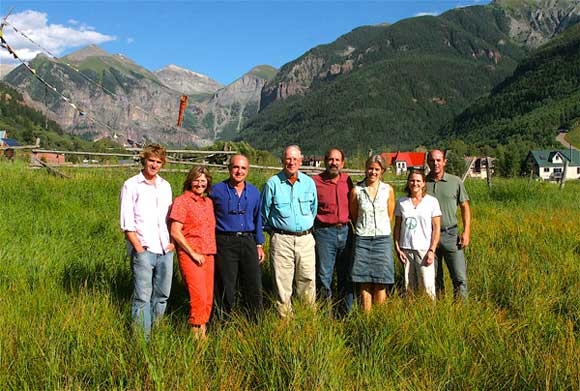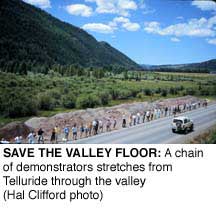The residents of Telluride, CO are personally and emotionally connected to the surrounding land, so much in fact, they would fight to preserve and protect it. The Valley (2018, dir. Bryan Reinhart) presents personal accounts and stories of just how important the natural land is for public use. Reinhart’s highly informative documentary illustrates a controversial dichotomy: democracy (politics) versus nature.

Telluride, CO – The Valley Floor
The Valley features the Valley Floor Preservation Partners (VFPP) and their thoughts on the changes Telluride and the valley has been going through since the ’70s, beginning with the town growing as a community of hippies and outdoor athletes. By sharing their personal experiences, they connect their daily lives to the environment.

Original Members of the VFPP Board and staff from left to right; David Allen, Jane Hickcox, Michael Zivian, Richard Moe, Terry Tice, Hilary White, Marla Croke, Todd Creel. Photo by Jeremy Baron.
Reinhart’s primary goal in making the documentary was to tell the story of how the town of Telluride was able to save the Valley Floor from development by raising money. In the ’90s, Neil Blue purchased the valley floor for six million dollars. The main issue was raised with the plan to build the San Miguel Valley Corporation structures with further development. From this issue, the documentary exposes the dichotomy between democracy (politics) and nature by showing humanity’s monetary possession of the valley floor. There is a photograph of Neil Blue that reveals text overlay saying Blue and the rest of the Corporation “refused to be interviewed” for this documentary. Reinhart was still able to include some still photographs of court documents concerning the Corporation, of course, but in telling this story Reinhart did well to stick with Telluride’s personal, not monetary, connection to the Valley Floor. Though, in order to preserve the valley, Telluride needed to buy the Valley. In showing this personal connection, footage of the residents of Telluride protesting against the Corporations can be seen. Their personal connection goes beyond monetary.

Residents of Telluride, CO set out to protest against development of the Valley Floor by trespassing.
In terms of cinematography, the documentary uses a unique, visual editing template where four interviews are played simultaneously in all four corners and forming four boxes that completely fill the screen. Each box appears in black and white and the audio is mute, but when the box turns to color the audio for that interview is heard. It is an interesting cinematic technique I can’t recall seeing before. Other rectangular shapes include footage of Telluride residents that appear in different sizes, appearing and disappearing randomly onscreen. This technique further shows the issue of preserving the valley was a widespread, consistent topic of conversation.
In the end, Telluride and the valley won the rights to preservation by raising the $50 million in three months from fundraisers and donations. The terms “condemnation” is repeated among the interviewees. Telluride residents agreed they would condemn and buy the valley, meaning even though the land needs to be bought by monetary means, the land will be used as a public, open space. Even though Telluride finds ownership of the land to be wrong, it must do so in order to preserve and protect it. In a ways, politics has to play a role in allowing nature to free.
After seeing the screening on May 23, 2019 at Mountainfilm, I felt a sense of agency and a call to action. The documentary’s message is clear to me: politics must play a role in preserving and protecting nature. The residents of Telluride protested by exercising their beliefs. They have a strong bond to the Valley that they are willing to buy the land so it is available for everyone to use. This story stands for everything Telluride values: preserving environments and building communities.
References:


Trackbacks/Pingbacks